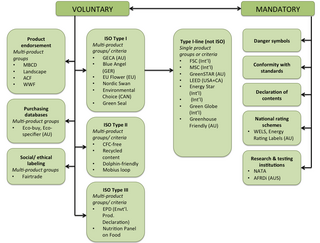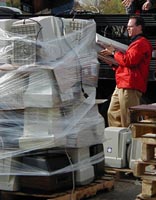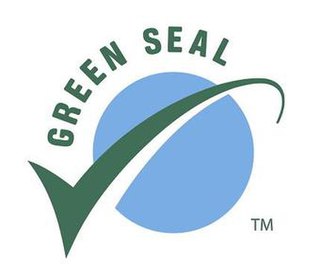Related Research Articles

Acer Inc. is a Taiwanese multinational hardware and electronics corporation specializing in advanced electronics technology, headquartered in Xizhi, New Taipei City. Its products include desktop PCs, laptop PCs, tablets, servers, storage devices, virtual reality devices, displays, smartphones and peripherals, as well as gaming PCs and accessories under its Predator brand. Acer is the world's 6th-largest PC vendor by unit sales as of September 2022.

Energy Star is a program run by the U.S. Environmental Protection Agency (EPA) and U.S. Department of Energy (DOE) that promotes energy efficiency. The program provides information on the energy consumption of products and devices using different standardized methods. The Energy Star label is found on more than 75 different certified product categories, homes, commercial buildings, and industrial plants. In the United States, the Energy Star label is also shown on the Energy Guide appliance label of qualifying products.

The Waste Electrical and Electronic Equipment Directive is a European Community Directive, numbered 2012/19/EU, concerned with waste electrical and electronic equipment (WEEE). Together with the RoHS Directive 2011/65/EU, it became European Law in February 2003. The WEEE Directive set collection, recycling and recovery targets for all types of electrical goods, with a minimum rate of 4 kilograms (9 lb) per head of population per annum recovered for recycling by 2009. The RoHS Directive set restrictions upon European manufacturers as to the material content of new electronic equipment placed on the market.

The Restriction of Hazardous Substances Directive 2002/95/EC, short for Directive on the restriction of the use of certain hazardous substances in electrical and electronic equipment, was adopted in February 2003 by the European Union.

On commercial products, the presence of the logo means that the manufacturer or importer affirms the goods' conformity with European health, safety, and environmental protection standards. It is not a quality indicator or a certification mark. The CE marking is required for goods sold in the European Economic Area (EEA); goods sold elsewhere may also carry the mark.

Ecolabels and Green Stickers are labeling systems for food and consumer products. The use of ecolabels is voluntary, whereas green stickers are mandated by law; for example, in North America major appliances and automobiles use Energy Star. They are a form of sustainability measurement directed at consumers, intended to make it easy to take environmental concerns into account when shopping. Some labels quantify pollution or energy consumption by way of index scores or units of measurement, while others assert compliance with a set of practices or minimum requirements for sustainability or reduction of harm to the environment. Many ecolabels are focused on minimising the negative ecological impacts of primary production or resource extraction in a given sector or commodity through a set of good practices that are captured in a sustainability standard. Through a verification process, usually referred to as "certification", a farm, forest, fishery, or mine can show that it complies with a standard and earn the right to sell its products as certified through the supply chain, often resulting in a consumer-facing ecolabel.
Green computing, green IT, or ICT sustainability, is the study and practice of environmentally sustainable computing or IT.

Electronic waste recycling, electronics recycling ore-waste recycling is the disassembly and separation of components and raw materials of waste electronics; when referring to specific types of e-waste, the terms like computer recycling or mobile phone recycling may be used. Like other waste streams, re-use, donation and repair are common sustainable ways to dispose of IT waste.

The ThinkCentre is a line of business-oriented desktop computers designed, developed and marketed by Lenovo, and formerly by IBM from 2003 to 2005. ThinkCentre computers typically include mid-range to high-end processors, options for discrete graphics cards, and multi-monitor support.

Product certification or product qualification is the process of certifying that a certain product has passed performance tests and quality assurance tests, and meets qualification criteria stipulated in contracts, regulations, or specifications.

Electronic waste or e-waste describes discarded electrical or electronic devices. It is also commonly known as waste electrical and electronic equipment (WEEE) or end-of-life (EOL) electronics. Used electronics which are destined for refurbishment, reuse, resale, salvage recycling through material recovery, or disposal are also considered e-waste. Informal processing of e-waste in developing countries can lead to adverse human health effects and environmental pollution. The growing consumption of electronic goods due to the digital revolution and innovations in science and technology, such as bitcoin, has led to a global e-waste problem and hazard. The rapid exponential increase of e-waste is due to frequent new model releases and unnecessary purchases of electrical and electronic equipment (EEE), short innovation cycles and low recycling rates, and a drop in the average life span of computers.
A rugged computer or ruggedized computer is a computer specifically designed to operate reliably in harsh usage environments and conditions, such as strong vibrations, extreme temperatures and wet or dusty conditions. They are designed from inception for the type of rough use typified by these conditions, not just in the external housing but in the internal components and cooling arrangements as well.
The Climate Savers Computing Initiative was a nonprofit group of consumers, businesses and conservation organizations dedicated to promoting smart technologies that improve power efficiency and reduce energy consumption of computers. Formed in 2007, it was based in Portland, Oregon. In July 2012, Climate Savers Computing Initiative combined with The Green Grid and its programs continue within that organization.

Green Seal is a non-profit environmental standard development and certification organization. Its flagship program is the certification of products and services. Certification is based on Green Seal standards, which contain performance, health, and sustainability criteria.

Electronic waste or e-waste in the United States refers to electronic products that have reached the end of their operable lives, and the United States is beginning to address its waste problems with regulations at a state and federal level. Used electronics are the quickest-growing source of waste and can have serious health impacts. The United States is the world leader in producing the most e-waste, followed closely by China; both countries domestically recycle and export e-waste. Only recently has the United States begun to make an effort to start regulating where e-waste goes and how it is disposed of. There is also an economic factor that has an effect on where and how e-waste is disposed of. Electronics are the primary users of precious and special metals, retrieving those metals from electronics can be viewed as important as raw metals may become more scarce

Electronic waste is a significant part of today's global, post-consumer waste stream. Efforts are being made to recycle and reduce this waste.

Mobile phone recycling describes the waste management of mobile phones, to retrieve materials used in their manufacture. Rapid technology change, low initial cost, and planned obsolescence have resulted in a fast-growing surplus, which contributes to the increasing amount of electronic waste around the globe.

Founded in 2005, the Global Electronics Council (GEC), formerly known as the Green Electronics Council, is a US-based environmental non-profit with a stated mission to "create a world where only sustainable technology is bought and sold".

The FCC logo or the FCC mark is a voluntary mark employed on electronic products manufactured or sold in the United States which indicates that the electromagnetic radiation from the device is below the limits specified by the Federal Communications Commission and the manufacturer has followed the requirements of the Supplier's Declaration of Conformity authorization procedures. The FCC label is found even on products sold outside the US territory, because they are either products manufactured in the US and had been exported, or they are also sold in the US. This makes the FCC label recognizable worldwide even to people to whom the name of the agency is not familiar.
Apple Inc. has received praise and criticism for its environmental practices. Since 2018, Apple exclusively uses renewable energy for its offices, data centers, and retail stores. The company has also announced plans to make its supply chain and products carbon neutral by 2030. In addition to reducing its carbon footprint, Apple has also reduced the use of hazardous chemicals in its products, and increased the use of recycled materials in its products. Apple also introduced trade-in and recycling programs in its Stores. Criticism of Apple primarily centers around its use of raw materials in manufacturing, and the amount of e-waste created by its products.
References
- ↑ "President Bush Requires Federal Agencies to Buy EPEAT Registered Green Electronic Products" (PDF) (Press release). Green Electronics Council. 2007-01-24. Archived from the original (PDF) on 2008-12-17. Retrieved 2007-09-20.
- ↑ "Executive Order: Strengthening Federal Environmental, Energy, and Transportation Management" (Press release). The White House: Office of the Press Secretary. 2007-01-24. Retrieved 2007-09-20.
- ↑ "Guidance on Purchasing EPEAT Registered Products (PDF)" (PDF). Archived from the original (PDF) on 2015-10-14.
- ↑ "Conformity Assurance Bodies - EPEAT". www.epeat.net. Archived from the original on 2016-05-08.
- ↑ Seth Weintraub (July 7, 2012). "Apple's new designs force it to abandon EPEAT Green standard, potentially cutting off big customers". 9to5mac.com. Retrieved October 21, 2012.